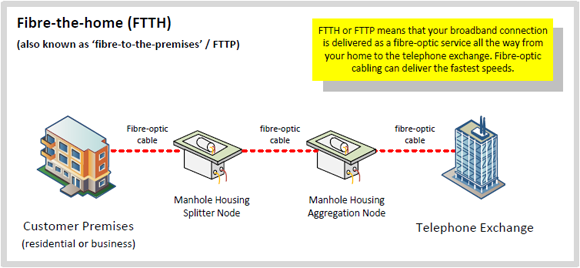- Related articles
- Optical Transceivers for Cisco SF300-24PP-K9-EU Switch
- What is network adapter?
- Apply to 100Base-LX Standard optical transceiver models
- Optical Transceivers for Cisco WS-C3650-24TD-L Switch
- All Cisco QSFP-100G-SR4-S's information (List price, Specs, Datasheet PDF, Compatibility m
- Difference between GLC-LH-SM and GLC-LH-SMD
- Applicable to 1000BASE-EX Standard Optical Transceiver Models
- Apply to 10GBASE-BX Standard Optical Transceiver Models
- All Cisco DS-CWDM-1470's information (List price, Specs, Datasheet PDF, Compatibility matr
- How Much Do You Know About Types of Fiber Optic Cables?

Introduction
FTTH is referred as the technology of transmitting data in form of pulse of light along the fiber optic cable. Currently, the FTTH are replacing the traditional copper wire. The main reason is that the fiber cable network is faster and more secure as compared to copper wire. Many companies are adopting the Fiber Cable Network with high rate and in near future, the Fiber Cable Network will dominate the market over the copper wire.

Reasons the FTTH fiber cables are replacing copper wires
• A FTTH network is easier to maintain and delivers 100 times more bandwidth than coaxial, wireless, or copper networks. It has virtually unlimited capacity to bring telephone, the Internet, digital television and other great services to subscribers — with high quality and reliability!
• FTTH Fiber Cable is capable of delivering a multitude of data, voice and video services to the home more efficiently and securely-versus traditional copper transport mediums. Fiber optic cables are comprised of hundreds or thousands of fiber optics, which are long thin strands of pure glass about the diameter of a human hair, which can carry data at speeds exceeding 2.5 gigabits per second (Gbps).
• FTTH Fiber Cable replaced the standard copper wire of the native Telco.
• Cable Systems Fiber offers a 100% fiber optic connection, while companies using partial fiber systems still rely on copper wire to deliver signals over extended distances, leading to poor signal quality. Only an FTTH network can carry high bandwidth signals over long distances using light, which has no interference issues and will deliver superior products.
• Typical copper telephone wires carry analog alerts generated by phone gear, including fax machines. Analog technology is, by nature, a less precise signaling technology than digital technology. Though multiplexing has allowed digital alerts to be transmitted across multiple channels over copper strains, FTTH fiber optic cable is superior for relaying these alerts and allows for quicker transfer charges and just about limitless bandwidth. This opens the door to higher Internet speed, streaming video, and other demanding applications.
• Copper cabling is an efficient means of delivering information over very short distances. However, networks that rely on partial fiber-to-copper infrastructure are subjected to extreme bottle-necking of information due to a limited amount of available bandwidth. They are susceptible to interference of radio frequencies (RF) and must continuously “refresh” or strengthen the signal to deliver it to the consumer’s home. FTTH networks have a virtually limitless bandwidth, which allows free flowing of information at the speed of light. Signals over fiber can travel greater distances without having to be refreshed and are not subject to RF interference.
• The Internet utilizes a backbone of fiber optic cables capable of delivering incredible bandwidth. This inherent ability makes it a prime source for advancing network technologies that can be brought to the home or business. Most subscribers, however, log on to this network through copper lines with limited capacity. This creates a bottleneck for advancing technologies that increasingly require greater bandwidth. FTTH bridges this gap.
• FTTH services commonly offer a fleet of plans with differing speeds that are price dependent. Fiber optical cable for FTTH helps define successful communities just as good water, power, transportation, public safety, and schools have done for decades. People can work from home – increasing personal productivity and decreased commute times and air pollution.
Conclusion
The adoption of Fiber Cable Network is gradually changing the way of living among many people. In the near future, the Fiber Cable Network will replace the copper wires completely. It’s more advanced features are giving it the upper hand over the copper wire hence making many people prefer using it.





















































